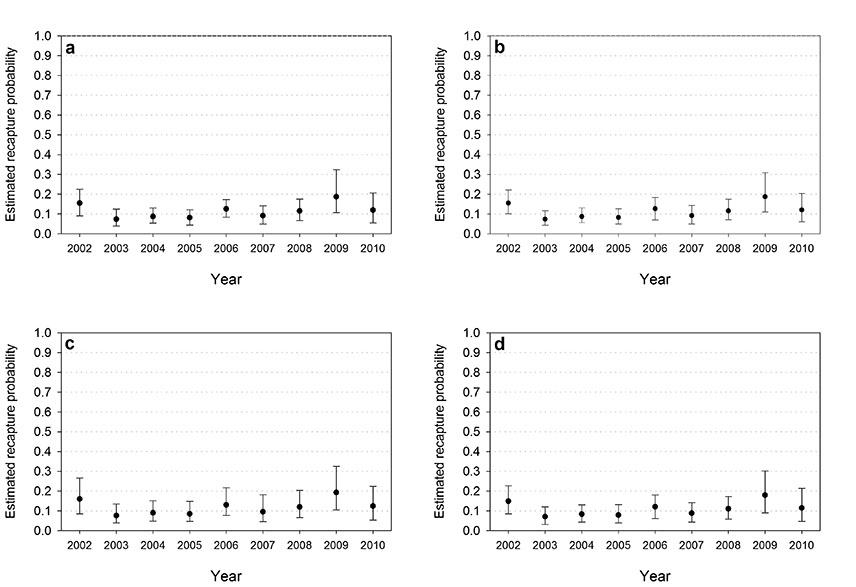
Ecological Archives A025-034-A3
Jeffrey F. Bromaghin, Trent L. McDonald, Ian Stirling, Andrew E. Derocher, Evan S. Richardson, Eric V. Regehr, David C. Douglas, George M. Durner, Todd Atwood, and Steven C. Amstrup. 2015. Polar bear population dynamics in the southern Beaufort Sea during a period of sea ice decline. Ecological Applications 25:634–651. http://dx.doi.org/10.1890/14-1129.1
Appendix C. Model-averaged estimates of recapture probabilities for southern Beaufort Sea polar bears and total model weights associated with recapture probability covariate structures.

Fig. C1. Model-averaged estimates of recapture probabilities, by age class and sex, for polar bears with a home stratum of Barrow, Alaska, based on the USGS data set; (a) adult males, (b) adult females and dependent young, (c) subadult males, and (d) subadult females. Estimates do not incorporate the influence of the covariates Radio or Cap-procliv. Error bars represent 90% bias-corrected confidence intervals based on 100 bootstrap samples.
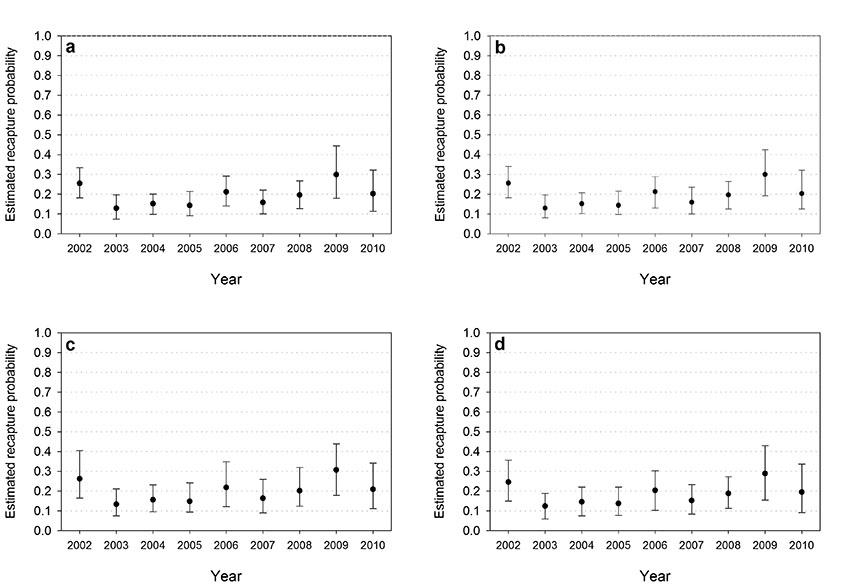
Fig. C2. Model-averaged estimates of recapture probabilities, by age class and sex, for polar bears with a home stratum of Deadhorse, Alaska, based on the USGS data set; (a) adult males, (b) adult females and dependent young, (c) subadult males, and (d) subadult females. Estimates do not incorporate the influence of the covariates Radio or Cap-procliv. Error bars represent 90% bias-corrected confidence intervals based on 100 bootstrap samples.
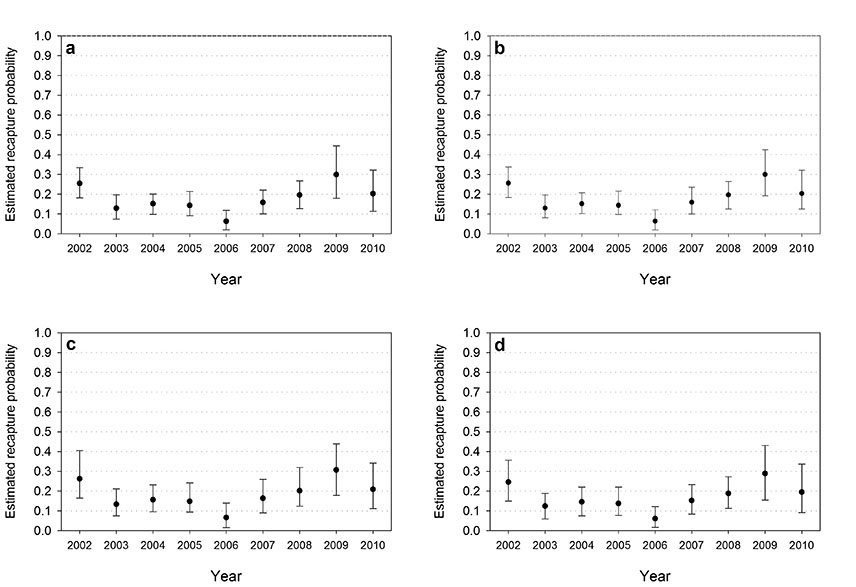
Fig. C3. Model-averaged estimates of recapture probabilities, by age class and sex, for polar bears with a home stratum of Barter Island, Alaska, based on the USGS data set; (a) adult males, (b) adult females and dependent young, (c) subadult males, and (d) subadult females. Estimates do not incorporate the influence of the covariates Radio or Cap-procliv. Error bars represent 90% bias-corrected confidence intervals based on 100 bootstrap samples.
Table C1. Total AICC model weight associated with age-sex and abiotic (temporal and geographic) covariate structures of recapture probability models based on the USGS data set. Covariate structures with a weight of less than 0.01 are excluded. A "+" denotes an additive term and "*" denotes a covariate interaction. Some covariates consisted of multiple related covariates that were always used jointly; details are provided in Appendix A.
|
|||
Source |
Covariate structure |
Weight |
|
Age-sex |
- |
0.443 |
|
Age-sex |
Age01.23Fem |
0.186 |
|
Age-sex |
Age2 |
0.177 |
|
Age-sex |
Age01.3Fem + Age2 + Age2Fem |
0.122 |
|
Abiotic |
Time + Home*US + BI2006 + Radio + Cap-procliv |
0.869 |
|
Abiotic |
Eff-US + Home*US + BI2006 + Radio + Cap-procliv |
0.079 |
|
Abiotic |
Home*US + BI2006 + Radio + Cap-procliv |
0.028 |
|
Abiotic |
Search-US + Home*US + BI2006 + Radio + Cap-procliv |
0.021 |
|
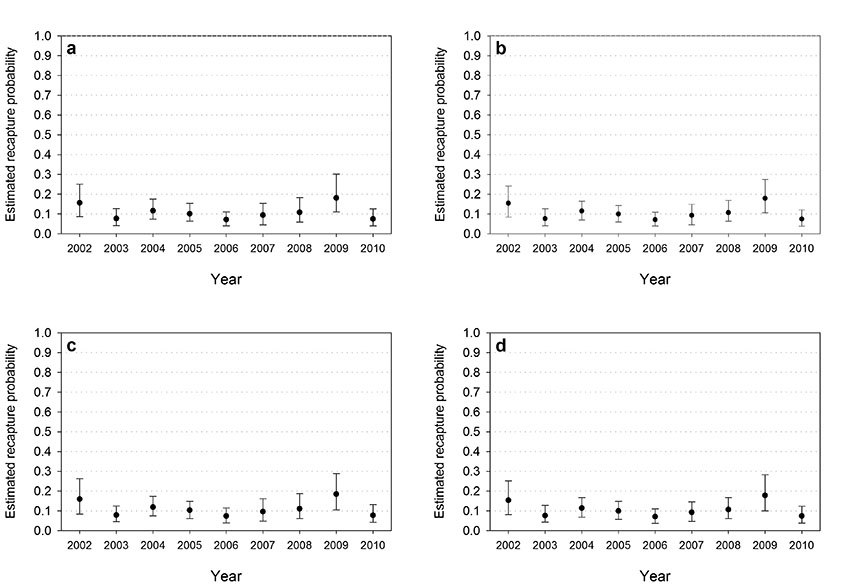
Fig. C4. Model-averaged estimates of recapture probabilities, by age class and sex, for polar bears with a home stratum of Barrow, Alaska, based on the USCA data set; (a) adult males, (b) adult females and dependent young, (c) subadult males, and (d) subadult females. Estimates do not incorporate the influence of the covariates Radio or Cap-procliv. Error bars represent 90% bias-corrected confidence intervals based on 100 bootstrap samples.
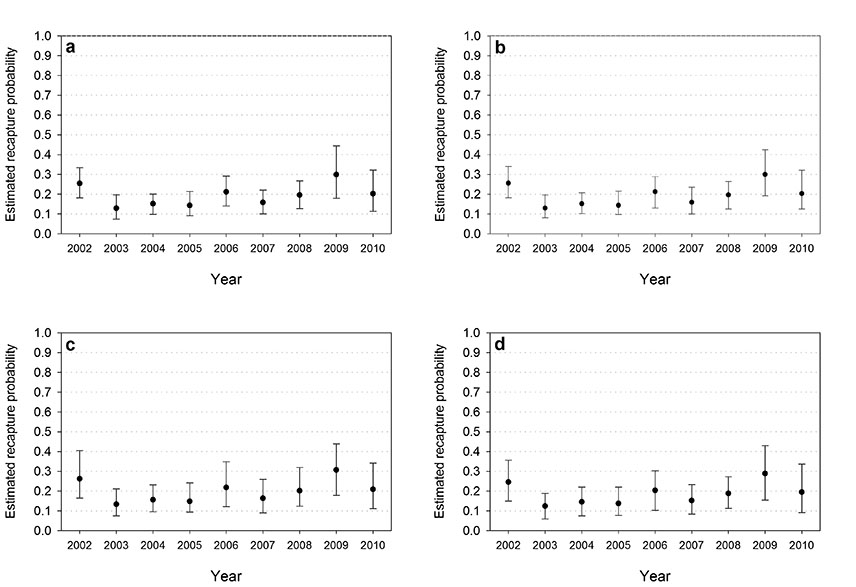
Fig. C5. Model-averaged estimates of recapture probabilities, by age class and sex, for polar bears with a home stratum of Deadhorse, Alaska, based on the USCA data set; (a) adult males, (b) adult females and dependent young, (c) subadult males, and (d) subadult females. Estimates do not incorporate the influence of the covariates Radio or Cap-procliv. Error bars represent 90% bias-corrected confidence intervals based on 100 bootstrap samples.

Fig. C6. Model-averaged estimates of recapture probabilities, by age class and sex, for polar bears with a home stratum of Barter Island, Alaska, based on the USCA data set; (a) adult males, (b) adult females and dependent young, (c) subadult males, and (d) subadult females. Estimates do not incorporate the influence of the covariates Radio or Cap-procliv. Error bars represent 90% bias-corrected confidence intervals based on 100 bootstrap samples.
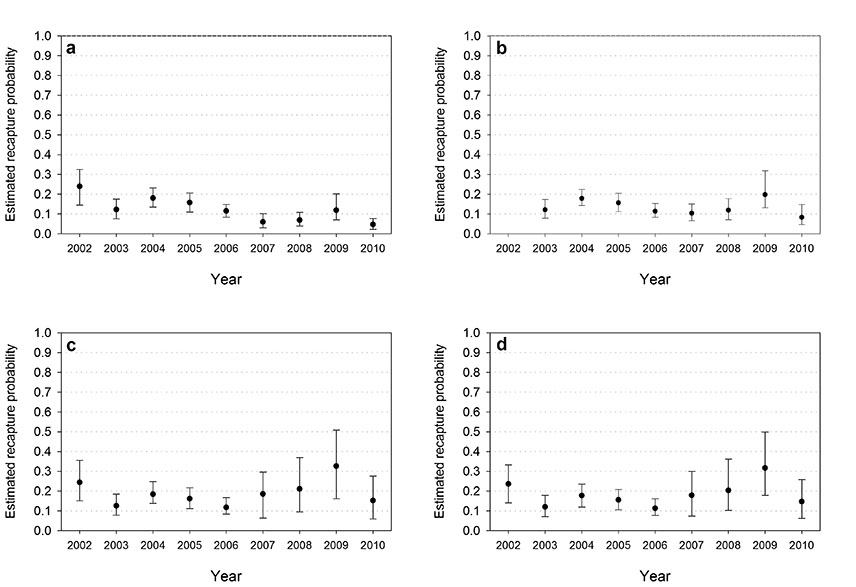
Fig. C7. Model-averaged estimates of recapture probabilities, by age class and sex, for polar bears with a home stratum of Canada, based on the USCA data set; (a) adult males, (b) adult females and dependent young, (c) subadult males, and (d) subadult females. Estimates do not incorporate the influence of the covariates Radio or Cap-procliv. Error bars represent 90% bias-corrected confidence intervals based on 100 bootstrap samples.
Table C2. Total AICC model weight associated with age-sex and abiotic (temporal and geographic) covariate structures of recapture probability models based on the USCA data set. Covariate structures with a weight of less than 0.01 are excluded. A "+" denotes an additive covariate term. Some covariates consisted of multiple related covariates that were always used jointly; details are provided in Appendix A.
Source |
Covariate structure |
Weight |
Age-sex |
UA |
0.521 |
Age-sex |
Age01.23Fem + UA |
0.219 |
Age-sex |
Age2 + UA |
0.184 |
Age-sex |
Age01.3Fem + Age2 + Age2Fem + UA |
0.075 |
Abiotic |
Time + Home + BI2006 + Eff-CA.l + Radio + Cap-procliv |
1.000 |